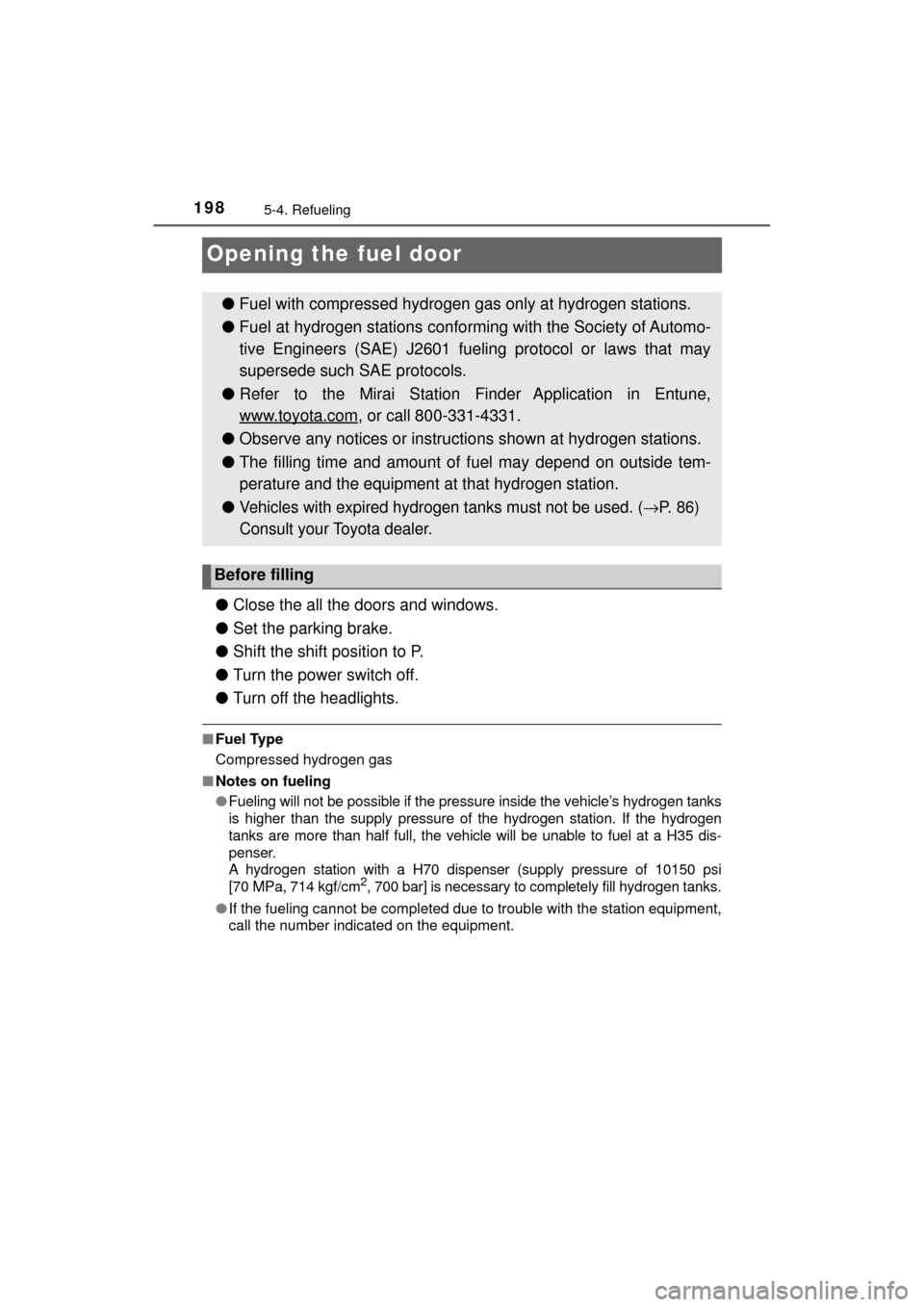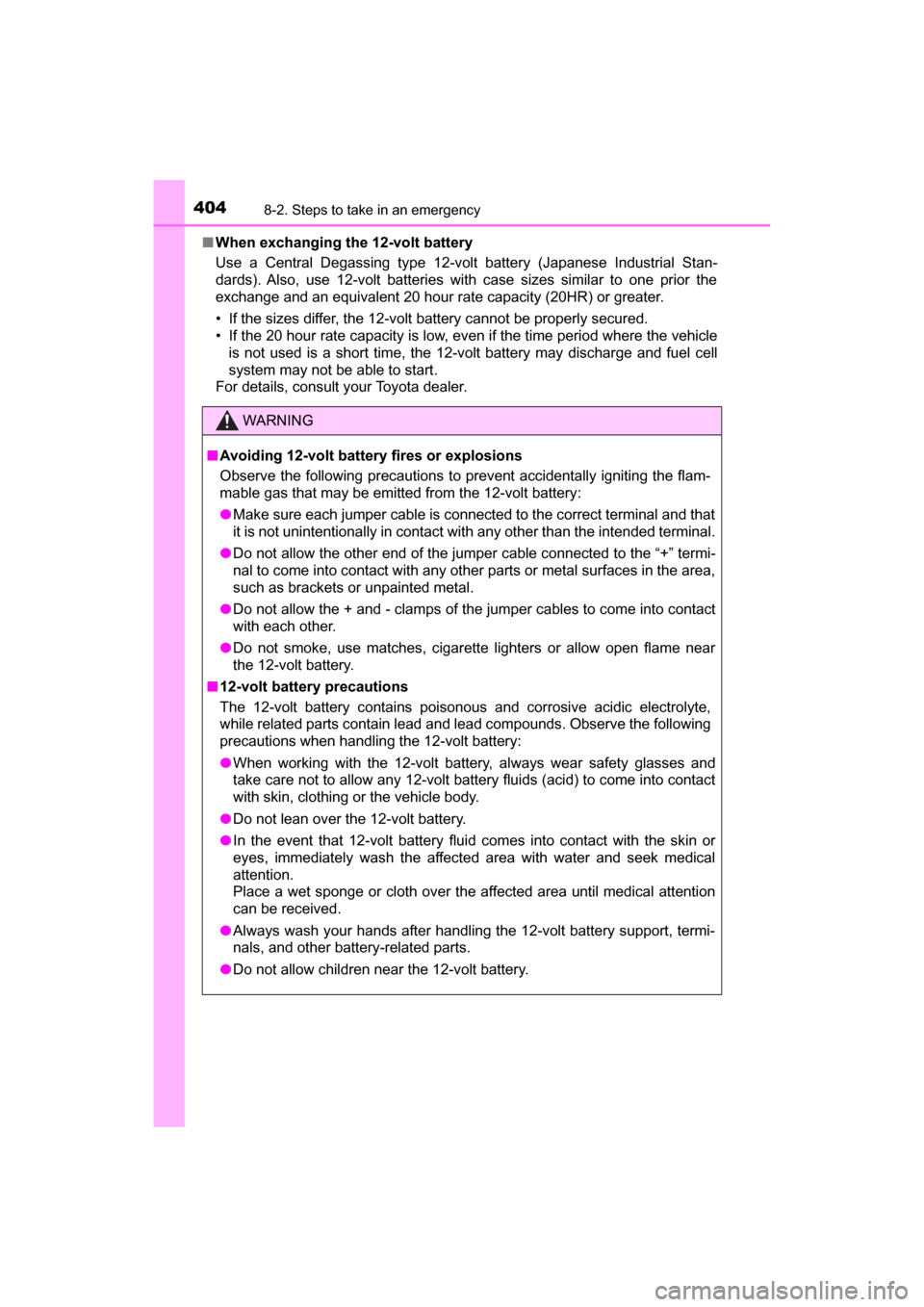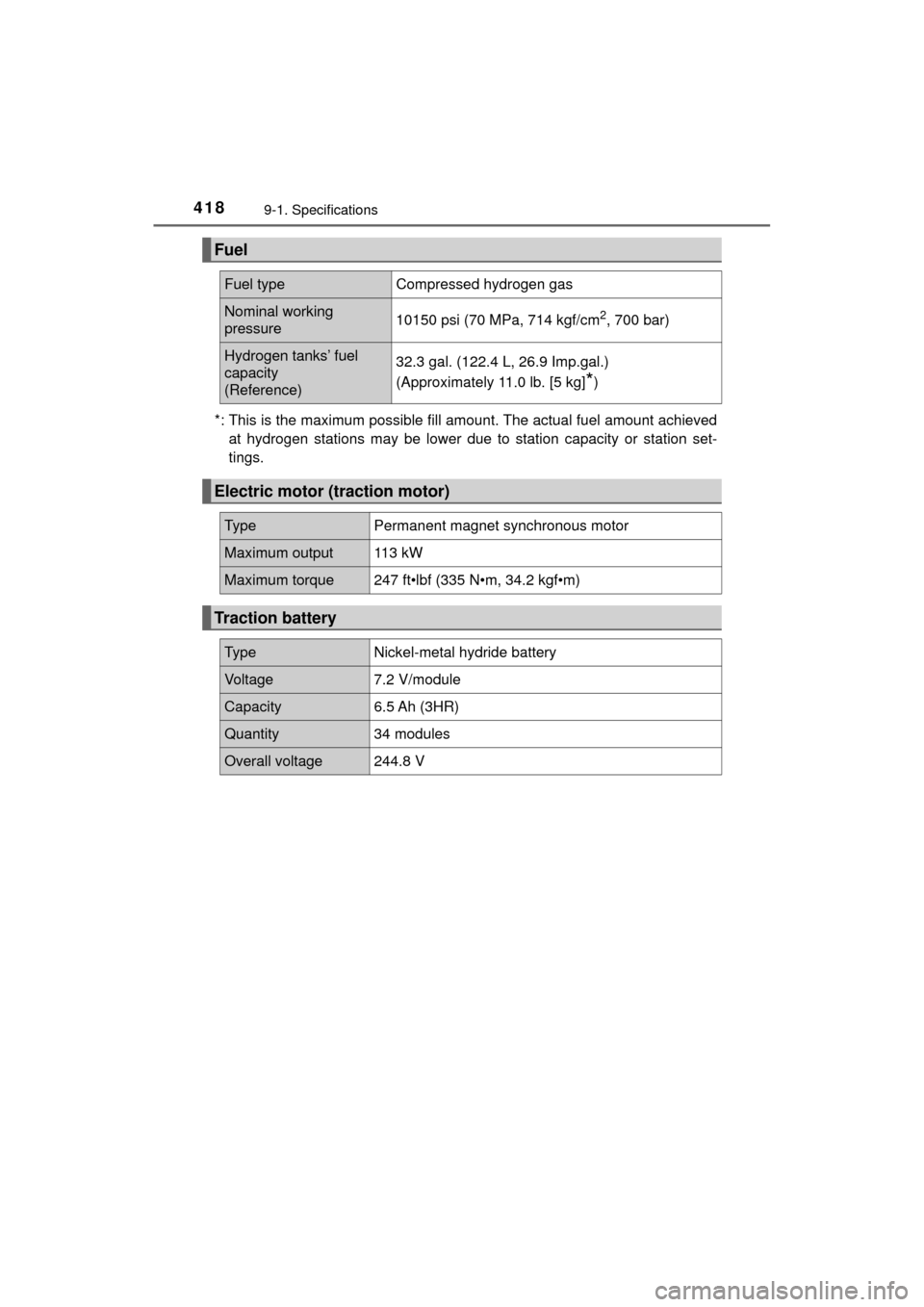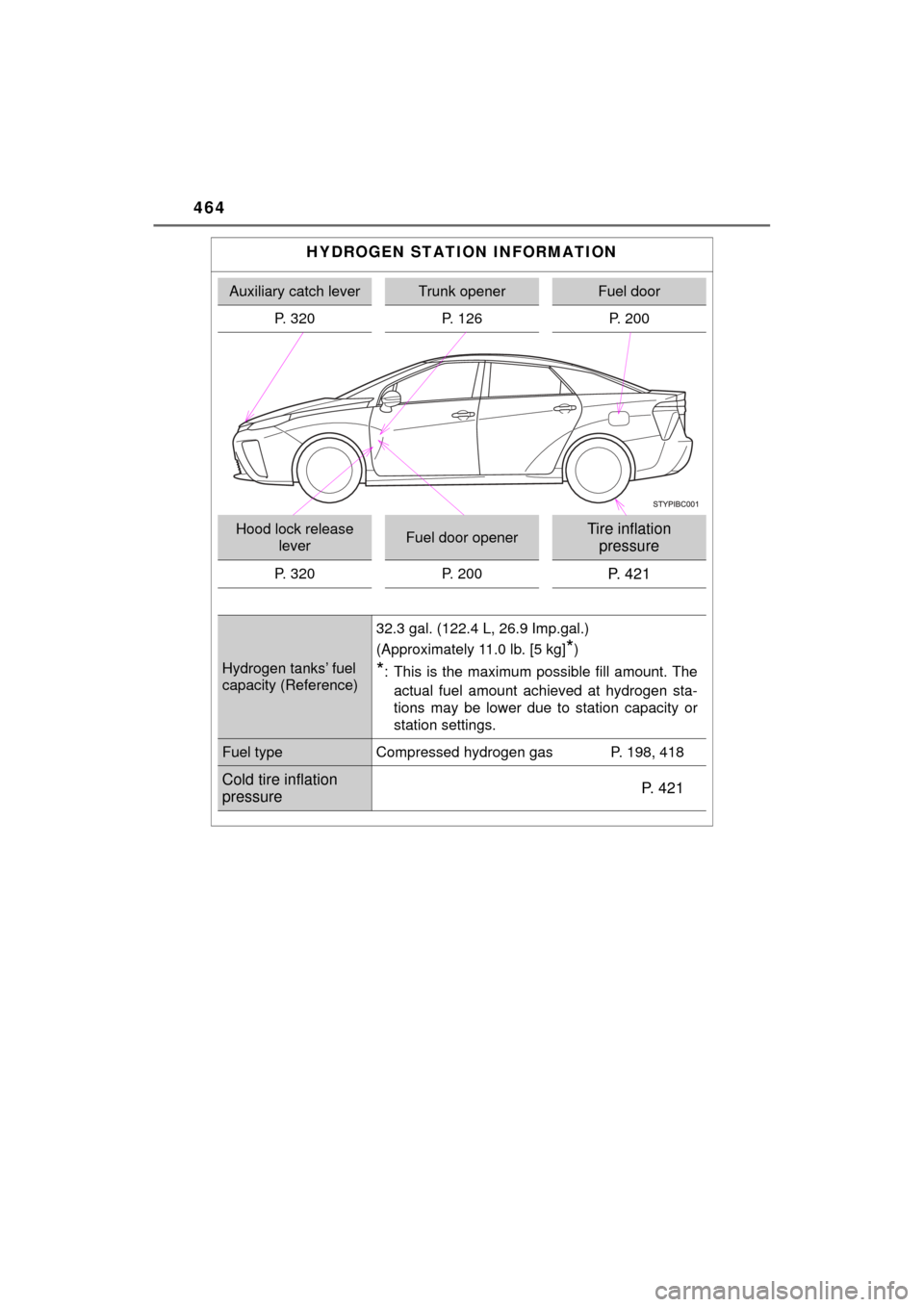2017 TOYOTA MIRAI gas type
[x] Cancel search: gas typePage 198 of 464

1985-4. Refueling
MIRAI_OM_USA_OM62023U
Opening the fuel door
●Close the all the doors and windows.
● Set the parking brake.
● Shift the shift position to P.
● Turn the power switch off.
● Turn off the headlights.
■Fuel Type
Compressed hydrogen gas
■ Notes on fueling
●Fueling will not be possible if the pressure inside the vehicle’s hydrogen tanks
is higher than the supply pressure of the hydrogen station. If the hydrogen
tanks are more than half full, the vehicle will be unable to fuel at a H35 dis-
penser.
A hydrogen station with a H70 dispenser (supply pressure of 10150 psi
[70 MPa, 714 kgf/cm
2, 700 bar] is necessary to completely fill hydrogen tanks.
● If the fueling cannot be completed due to trouble with the station equipment,
call the number indicated on the equipment.
● Fuel with compressed hydrogen ga s only at hydrogen stations.
● Fuel at hydrogen stations confor ming with the Society of Automo-
tive Engineers (SAE) J2601 fueling protocol or laws that may
supersede such SAE protocols.
● Refer to the Mirai Station Finder Application in Entune,
www.toyota.com
, or call 800-331-4331.
● Observe any notices or instructio ns shown at hydrogen stations.
● The filling time and amount of fuel may depend on outside tem-
perature and the equipment at that hydrogen station.
●
Vehicles with expired hydro gen tanks must not be used. (→P. 86)
Consult your Toyota dealer.
Before filling
Page 312 of 464

3127-1. Maintenance and care
MIRAI_OM_USA_OM62023U
NOTICE
■Cleaning detergents
● Do not use the following types of detergent, as they may discolor the vehi-
cle interior or cause streaks or damage to painted surfaces:
• Non-seat portions: Organic substances such as benzene or gasoline,
alkaline or acidic solutions, dye, and bleach
• Seats: Alkaline or acidic solutions, such as thinner, benzene, and alco- hol
● Do not use a polish wax or polish cleaner. The instrument panel’s or other
interior part’s painted surface may be damaged.
■ Preventing damage to leather surfaces
Observe the following precautions to avoid damage to and deterioration of
leather surfaces:
● Remove any dust or dirt from leather surfaces immediately.
● Do not expose the vehicle to direct sunlight for extended periods of time.
Park the vehicle in the shade, especially during summer.
● Do not place items made of vinyl, plastic, or containing wax on the uphol-
stery, as they may stick to the leather surface if the vehicle interior heats
up significantly.
■ Water on the floor
Do not wash the vehicle floor with water.
Vehicle systems such as the audio system may be damaged if water comes
into contact with electrical components such as the audio system above or
under the floor of the vehicle. Water may also cause the body to rust.
■ When cleaning the inside of the windshield
Be careful not to touch the camera sensor ( →P. 216).
If the camera is accidentally scratched or hit, LDA system and Automatic
High Beam may not operate properly or may cause a malfunction.
■ Cleaning the inside of the rear window
● Do not use glass cleaner to clean the rear window, as this may cause
damage to the rear window defogger heater wires or antenna. Use a cloth
dampened with lukewarm water to gently wipe the window clean. Wipe the
window in strokes running parallel to the heater wires or antenna.
● Be careful not to scratch or damage the heater wires or antenna.
Page 404 of 464

4048-2. Steps to take in an emergency
MIRAI_OM_USA_OM62023U■
When exchanging the 12-volt battery
Use a Central Degassing type 12-volt battery (Japanese Industrial Stan-
dards). Also, use 12-volt batteries with case sizes similar to one prior the
exchange and an equivalent 20 hour rate capacity (20HR) or greater.
• If the sizes differ, the 12-volt battery cannot be properly secured.
• If the 20 hour rate capacity is low, even if the time period where the vehicle
is not used is a short time, the 12-volt battery may discharge and fuel cell
system may not be able to start.
For details, consult your Toyota dealer.
WARNING
■ Avoiding 12-volt battery fires or explosions
Observe the following precautions to prevent accidentally igniting the flam-
mable gas that may be emitted from the 12-volt battery:
● Make sure each jumper cable is connected to the correct terminal and that
it is not unintentionally in contact with any other than the intended terminal.
● Do not allow the other end of the jumper cable connected to the “+” termi-
nal to come into contact with any other parts or metal surfaces in the area,
such as brackets or unpainted metal.
● Do not allow the + and - clamps of the jumper cables to come into contact
with each other.
● Do not smoke, use matches, cigarette lighters or allow open flame near
the 12-volt battery.
■ 12-volt battery precautions
The 12-volt battery contains poisonous and corrosive acidic electrolyte,
while related parts contain lead and lead compounds. Observe the following
precautions when handling the 12-volt battery:
● When working with the 12-volt battery, always wear safety glasses and
take care not to allow any 12-volt battery fluids (acid) to come into contact
with skin, clothing or the vehicle body.
● Do not lean over the 12-volt battery.
● In the event that 12-volt battery fluid comes into contact with the skin or
eyes, immediately wash the affected area with water and seek medical
attention.
Place a wet sponge or cloth over the affected area until medical attention
can be received.
● Always wash your hands after handling the 12-volt battery support, termi-
nals, and other battery-related parts.
● Do not allow children near the 12-volt battery.
Page 418 of 464

4189-1. Specifications
MIRAI_OM_USA_OM62023U*: This is the maximum possible fill amount. The actual fuel amount achieved
at hydrogen stations may be lower due to station capacity or station set-
tings.
Fuel
Fuel type Compressed hydrogen gas
Nominal working
pressure10150 psi (70 MPa, 714 kgf/cm2, 700 bar)
Hydrogen tanks’ fuel
capacity
(Reference)32.3 gal. (122.4 L, 26.9 Imp.gal.)
(Approximately 11.0 lb. [5 kg]
*)
Electric motor (traction motor)
Type
Permanent magnet synchronous motor
Maximum output 113 kW
Maximum torque 247 ft•lbf (335 N•m, 34.2 kgf•m)
Traction battery
TypeNickel-metal hydride battery
Voltage7.2 V/module
Capacity 6.5 Ah (3HR)
Quantity34 modules
Overall voltage 244.8 V
Page 453 of 464

453Alphabetical index
MIRAI_OM_USA_OM62023U
Flat tire...................................... 381
Floor mats .................................. 26
FluidBrake .................................... 420
Transmission ........................ 420
Washer ................................. 327
Front interior lights ................. 270 Wattage ................................ 421
Front passenger occupant classification system .............. 49
Front seats ............................... 138
Adjustment ............................ 138
Cleaning................................ 310
Correct driving posture ........... 28
Driving position memory ....... 140
Head restraints ..................... 145
Power easy access system ......... ....................... 140
Seat heaters ......................... 268
Seat position memory ........... 140
Front side marker lights.......... 187 Light switch ........................... 187
Replacing light bulbs............. 358
Front turn signal lights ........... 185 Replacing light bulbs............. 358
Turn signal lever ................... 185
Fuel
Capacity ................................ 418
Fuel gauge ............................ 102
Hydrogen station information.......................... 464
Refueling............................... 198
Type .............................. 198, 418
Warning light ......................... 371
Fuel cell stack ............................ 86
Fuel cell stack coolant Capacity ................................ 419
Checking ............................... 324 Fuel cell system
Characteristics ........................ 78
Cold temperatures ................ 175
Coolant type ......................... 419
Indicators .............................. 100
Multi-information display ....... 107
Precautions............................. 82
Starting the system ............... 172
Stopping the system ............. 173
Warning lights ......................... 99
Fuel cell system indicator ...... 110
Fuel cell vehicles
Characteristics ........................ 78
Charging the traction battery .................................. 81
Driving advice ......................... 94
Emergency shut off system .... 84
Emergency start function ...... 397
Emergency stops .................. 361
Fuel....................................... 418
Handling hydrogen gas........... 90
High-voltage components ....... 83
Hydrogen gas ......................... 89
Hydrogen-related components.......................... 82
If the 12-volt battery is discharged.......................... 401
If the fuel cell system will not start ........................ 396
Maintenance, repair,
recycling, and disposal ......... 81
F
Page 464 of 464

464
MIRAI_OM_USA_OM62023U
HYDROGEN STATION INFORMATION
Auxiliary catch leverTrunk openerFuel door
P. 320 P. 126P. 200
Hood lock release
leverFuel door openerTire inflation pressure
P. 320 P. 200P. 421
Hydrogen tanks’ fuel
capacity (Reference)32.3 gal. (122.4 L, 26.9 Imp.gal.)
(Approximately 11.0 lb. [5 kg]
*)
*: This is the maximum possible fill amount. The
actual fuel amount achieved at hydrogen sta-
tions may be lower due to station capacity or
station settings.
Fuel type Compressed hydrogen gas P. 198, 418
Cold tire inflation
pressure P. 4 2 1